|
North America conjures up thoughts of cacti, but there are many other succulent plants to be found there. The most obvious are the succulent monocotyledons (Agavaceae, Nolinaceae). Some of these can grow to be too large to fit into a small collection. Agaves have a habit of flowering through the greenhouse roof, which may explain why many growers ignore these attractive succulents. Some Yuccas are sufficiently hardy to tolerate cold-wet winters, while others suit Mediterranean and dry tropical climates.
However, a sharp eye will find a range of attractive small succulent plants in several families including Asclepiadaceae, Crassulaceae, Euphorbiaceae and Portulacaceae. The Cactaceae come in a wide range of sizes from tiny buttons to large columns and many species are amenable to glasshouse cultivation.
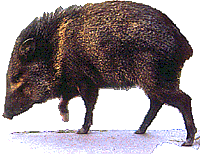 Many succulent plants found in the North American mountains are frost hardy under the very dry conditions in which they flourish, but may not survive the cold in a wetter climate. They may do well if protected from rain by a cold frame. Indeed some North American cacti flower the better for a cold, dry Winter.
Many succulent plants found in the North American mountains are frost hardy under the very dry conditions in which they flourish, but may not survive the cold in a wetter climate. They may do well if protected from rain by a cold frame. Indeed some North American cacti flower the better for a cold, dry Winter.
You can download higher quality images by clicking on the pictures below.
Photographs © copyright R.J. Hodgkiss.
|
Agavaceae - Agaves (Century Plants), Yuccas |
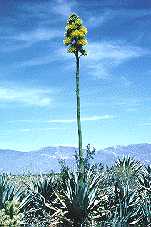
Left: Agave deserti - This Desert Agave was part of a fine stand of flowering succulent plants in April 1995. Sometimes called the "century plant", in practice flowering occurs after 8 - 20 years. Although all the flowering rosettes will die, each group of Agave at this site had plenty of offset non-flowering rosettes for other years. The leaves of the rosettes are armed with lethal stiff terminal spines, for which one rapidly acquires respect, and sharp marginal teeth. Desert Agave is one of the most drought-tolerant of the 136 species of Agave found in North America, and grows on stony terrain from south-eastern California and south-western Arizona to Baja California and northern Sonora. Many species of Agave are bat pollinated.
The starchy core of the Desert Agave was baked in rock-lined pits by desert-dwelling Indians to form a nutritious energy-rich staple food, and baked agave can still be purchased in Mexican markets. Fermentation of the starchy core of some species and distillation of the ferment is the basis for production of tequilla and mescal.
More about the genus Agave: The Agave Page
|
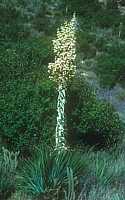
Many species of Yucca are spread over the south-western USA. Inter-specific hybridization sometimes makes positive identification difficult. Native American Indians used many parts of these succulent plants for food, clothing, baskets, fibre and soap. Their free-flowering habit makes them attractive components of dry landscaping.
Left: Yucca whipplei (Our Lord's Candle)
Unlike Agaves, Yuccas can flower many times. Self pollination of Yucca flowers of many species is almost impossible and they are pollinated exclusively by small Yucca moths, with the plant and moth totally dependent on each other.
More about the genus Yucca: The Yucca Page
|
|
|
Cacti are one of the most distinctive groups of succulent plant growing throughout the American continent, with around 2500 species ranging in size from less than half an inch to tens of feet in height. North-American cacti are distributed across a wide area from Canada to Mexico. Mexico is a hot-spot for cacti but many species can seen flowering in the Southern USA in a band from Texas to California.
Upper Right: Opuntia engelmannii var. engelmannii is one of a large group of Prickly Pears within the Cactaceae. The jointed spiny succulent stems can be flat (Prickly Pears) or cylindrical (Chollas).
Lower Right: The Living Rock Cactus Ariocarpus fissuratus is atypical of most cacti in having no spines and flowering in the Autumn.
|

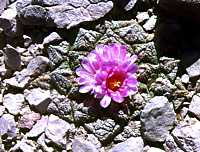 |
|
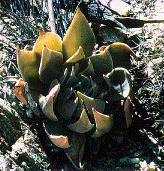
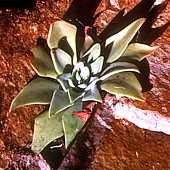
|
Dudleya is a genus of more than 50 small rosetted succulent plants native to Arizona, California, Nevada, Oregon, Baja California, Mexico and coastal islands and possibly extending into S. America. Many Dudleya species grow along the Californian coast.
Left: A large rosetted Dudleya found on very dry hillsides in California along highway S2. Plants growing in shade have succulent green leaves but develop an attractive bronze colour when exposed to direct sunlight. Rosettes grow up to 8 in across.
Echeveria have a similar appearance to Dudleya but are not closely related. Over a hundred species of these succulent plants can be found in Mexico, central and S. America. Echeveria leaves will root and form new plants whereas Dudleya leaves will not.
Left: Just one species of Echeveria (E. strictiflora) is native to Texas. It grows on rocks within the baisin area in the Chisos Mountains.
|
|
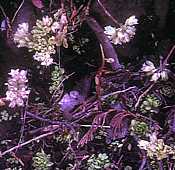 |
It is often worth walking up rocky hillsides, paying careful attention to cracks in rocks, providing microclimates where succulents such as Sedums, Dudleyas and small Cacti may flourish.
Left: Sedum wrightii growing on wet rocks near Boot Spring, Chisos Mountains, Texas.
|
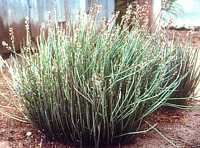
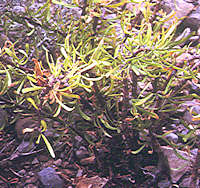
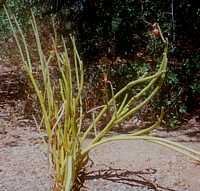
|
Top left:The candelilla plant (Euphorbia antisyphyllitica) growing at the Langtry visitor center, Texas. The epiphet antisyphyllitica refers to this succulent Euphorbia's supposed medicinal properties. The flowers are relatively decorative by the standard of many Euphorbia. This succulent plant is relatively common in the Big Bend country and the Rio Grande valley but in its natural habitat, where water may be scarce and the heat intense, the stems often have a bronzed appearance. The protective waxy surface of the stems retains moisture.
The candelilla plant was an important source of candelilla wax, which is still produced in small quantities by boiling large quantities of stems with sulphuric acid, and skimming the wax from the surface of the vat. The wax was used in the manufacture of phonograph records, in cosmetics and as an industrial lubricant.
Middle left: Dragon's blood, Leatherstem, Jatropha dioica, growing on limestone in a very dry valley, South of Shafter, Texas. The cut stems of this succulent shrub exude a clear sap that turns red and was used as a dye.
Bottom left: Pedilanthus macrocarpus, (Slipper Plant) from Sonora and Baja California, growing in the Phoenix Desert Botanical Garden. The flowers attract humming birds. This species is an excellent succulent plant for a container in a warm climate but will not stand any frost.
The Spurge Page
|
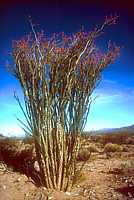 |
Left: Fouquieria splendens
Probably my favourite North American xerophytic plant, the Ocotillo or Devil's Walking Stick is widespread from Texas to California and northern Mexico. The red flowers are attractive to migratory humming birds.
The Fouquieria Page
|
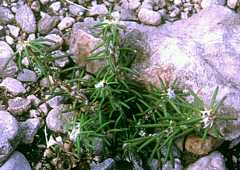
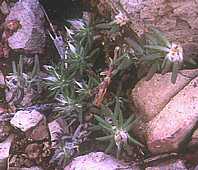 |
Extreme Left: Portulaca pilosa Shaggy Portulaca in the Big Bend National Park.
This weedy succulent plant is widely distributed on stony ground in the South-Western USA.
Left: South of Shafter, Texas. The tiny pink flowers in the middle of a tuft of white hairs at the end of stems are easily overlooked.
More about Portulacaceae
|
| |
Nolinaceae - beargrasses & sotol |
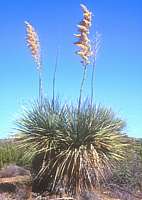
|
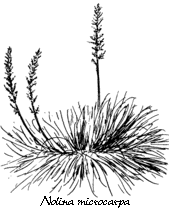 Many Nolinas (beargrasses) flourish on dry hillsides where little else will grow. The tuft of leaves hides a succulent caudex or short trunk which stores water and food reserves. The large decorative inflorescence bears thousands of tiny cream-coloured flowers.
Many Nolinas (beargrasses) flourish on dry hillsides where little else will grow. The tuft of leaves hides a succulent caudex or short trunk which stores water and food reserves. The large decorative inflorescence bears thousands of tiny cream-coloured flowers.
Left: Nolina parryi ssp. wolfii in N. Arizona.
The Beargrass Page: Nolina
|
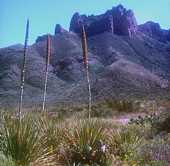
|
The leaves of Dasylirions (Sotol) are furnished with sharp teeth. The starchy core of the developing inflorescence was traditionally roasted and eaten, the leaves used for weaving baskets and thatching and the dead inflorescence was a source of wood. The scoop-shaped woody leaf base can be used as a "desert spoon".
Left: Dasylirion leiophyllum (Sotol) growing in front of the Chisos Mountains, Texas. This hardy succulent plant is widely cultivated as a xerophytic ornamental for dry landscaping.
The Beargrass Page: Dasylirion
|
|
Right: Asclepias erosa
The semi-succulent desert milkweed (Asclepias erosa) with striking green balls of florets, photographed in April 1995, in the Anza-Borrego Desert State Park, California. Asclepias species produce nectar which attracts pollinator flies such as hoverflies and wasps such as the tarantula wasp. They are also attractive to humming birds. Desert milkweed is widespread from southern Utah to southeastern California, western Arizona and northwestern Mexico.
Asclepias species are often known as "butterfly weeds" and cultivated as the food plant of the caterpillars of several species of butterflies including the North American Monarch butterfly Danaus plexippus.
More about Asclepias
|
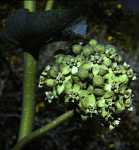
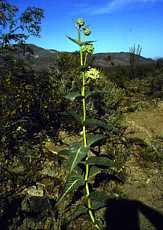
|
























 Many
Many 

